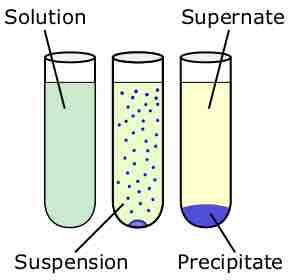Coordination complexes can be used to analyze chemical composition in a variety of ways. Two common techniques are precipitation analysis and colorimetric analysis. These methods are called classical qualitative inorganic analysis.
Qualitative Inorganic Analysis
Classical qualitative inorganic analysis is a method of analytical chemistry that seeks to find the elemental compositions of inorganic compounds. It is mainly focused on detecting ions in aqueous solution, so materials in other forms may need to be brought into this state before standard methods can be used. The solution is then treated with various reagents to test for reactions characteristic of certain ions, which may cause color changes, solid formation, or other visible changes.

Precipitation reaction
Difference in the visual appearance of an aggregate and a precipitate.
Precipitation Analysis
Cations are usually classified into one of six groups according to their properties, while anions are classified into one of three groups. The details of classification vary slightly from one source to another. Each group has a common reagent that can be used to separate the cation or anion from a solution. To obtain meaningful results, the separation must be done in a specific sequence, as some ions of an earlier group may also react with the reagent of a later group, leading to ambiguity as to which ions are present. This happens because cationic analysis is based on the solubility products of the ions. As the cation achieves the optimum concentration needed, it precipitates, allowing detection.
Precipitation analysis
Copper from a wire displaces silver in a silver nitrate solution it is dipped into, and solid silver precipitates out. Precipitation analysis can be used to determine the chemical makeup of the solution.
The groups of cations include:
- Those that form insoluble chlorides, such as lead, silver, and mercury.
- Those that form acid-insoluble sulfides, such as cadmium, bismuth, copper, antimony, and tin.
- Those that form insoluble hydroxide complexes, such as iron, aluminum, and chromium.
- Zinc, nickel, cobalt, and manganese are determined by the addition of ammonium chloride, ammonium hydroxide, and hydrogen sulfide gas. The color of the precipitate will indicate the metal.
- A group of insoluble carbonate salts. (While many of the earlier cations will precipitate with carbonate, they will have been detected prior to this point if the steps have been followed in order.) Barium, calcium, and strontium will precipitate at this point, but not before.
- Magnesium, lithium, sodium, potassium, and ammonium are difficult to precipitate and are usually detected by flame color.
There are three groups of anions, and their detection methods vary widely. However, precipitation methods similar to those mentioned above are often used.
Colorimetric Analysis
Colorimetric analysis is a method of determining the concentration of a chemical element or chemical compound in a solution with the aid of a color reagent. It is applicable to both organic compounds and inorganic compound. The method is widely used in medical laboratories and for industrial purposes, such as the analysis of water samples in connection with industrial water treatment.